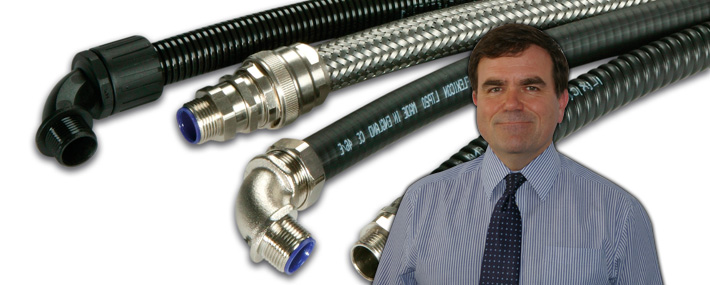When identifying products, you may see terms such as “suitable for outdoor use” and “weatherproof”. It is important to be careful when selecting products that claim these properties, and to establish to what “weatherproof” actually means.
Bearing in mind that we live in temperate conditions and climates vary throughout the world, just look at Britain’s weather in the past 18 months; drought last winter, followed by the second wettest calendar year, sub-zero snow-storms bringing the country to a standstill and so far a summer which is only just rearing its head. With such unpredictable weather within the UK, you can understand why weatherproof can mean different things in different parts of the world, to different manufacturers.
Flexicon’s technical director, Ian Gibson, warns that before specifying outdoor protection, make sure you clearly define exactly what it is you require. With such a wide scope of local climates, manufacturers should have a wide range of products to choose from. Flexicon, for instance, has 48 different flexible conduit systems with hundreds of variations when it comes to terminations.
There are a number of factors that should be considered when evaluating the true level of weather-proofing a product possesses. IP ratings are considered a primary factor but this should not be the only factor considered.
IP Ratings
The first number on a product’s ingress protection rating describes its resistance to solids and dust, the second number represents the protection against water and moisture ingress.
It’s important to remember the IP rating of a termination product, such as a cable or conduit gland, usually refers to the outer seal and an extra washer may be required to achieve the same IP rating on the equipment or enclosure entry. More information can be found here.
Ian recommends, when considering flexible conduits, the conduit should have a minimum of IP6x when it comes to dust ingress, regardless of the conduit’s application.
The different levels of ingress protection are outlined in the chart below.
| 1st Digit (Solid Objects) | 2nd Digit (Water and Moisture) | ||||
| # | Explanation | # | Explanation | ||
| 0 | Non-Protected | 0 | Non-Protected | ||
| 1 |  |
Protected against solid foreign objects of 50mm diameter and greater | 1 |  |
Protected against drops of water falling vertically |
| 2 |  |
Protected against solid foreign objects of 12.5mm diameter and greater | 2 |  |
Protected against drips of water falling up to 15o from the vertical |
| 3 |  |
Protected against solid foreign objects of 2.5mm diameter and greater | 3 |  |
Protected against spraying water at up to 60o from the vertical |
| 4 |  |
Protected against solid foreign objects of 1.0mm diameter and greater | 4 |  |
Protected against splashing water from all directions |
| 5 |  |
Dust-protected | 5 |  |
Protected against jet of water from all directions |
| 6 |  |
Dust-tight | 6 |  |
Protected against jet of water similar for to heavy seas |
| 7 |  |
Protected against the effects of immersion | |||
| 8 |  |
Protected against prolonged effects of immersion under pressure to a specified depth. | |||
| 9K | Steam clean, high pressure temp jet wash to DIN40050 | ||||
When considering what moisture ingress protection is required, it is recommended to take a ‘belt and braces’ approach to prevent water ingress over longer periods of time. Therefore, a rating of IPX6 or IPX7 should be specified, unless the fitting is suitably sheltered, such as on the underside of an enclosure.
Ultraviolet Degradation
The amount of UV radiation that a product is exposed to will depend on location, altitude and climate. The ultraviolet rays will affect the performance of plastic materials by breaking down the long polymer chains, reducing the impact strength, flexibility and working life of the product.
Although other coloured plastics can be manufactured to be UV resistant, Flexicon predominately offer black plastics as the carbon black within them helps protect the polymer chains.
Corrosion
Corrosion becomes an issue if metal conduits and fittings are used. Coated steel is preferred, as long as its IP rating is sufficient to prevent water entering the conduit.
Nickel-plated brass fittings will discolour through oxidisation over time, especially in coastal areas. Grade 316 stainless steel is recommended for use in marine environments.
Temperature
When considering temperature, generally the maximum temperature reached naturally by the weather will not present an issue with most products. Colder temperatures can cause more of a problem; you should consider the potential hazards to which a product might be exposed, to prevent failure during operation or installation.
Flexicon understand the need to have products that fit the harsh and sometimes unpredictable climates around the world. Their LTP flexible conduits, when used with stainless steel fittings, represents an all-round “weatherproof” product, with an IP rating up to IP69k and operating temperature ranging between -20oC to 105oC. The LTPHC range extends this temperature range to -60oC to 150oC.
Ian Gibson, technical director at Flexicon is also the chairman of both the IEC (Worldwide) and CENELEC (European) committees that prepare conduit standards.
If you found this article helpful or interesting, please share it!














